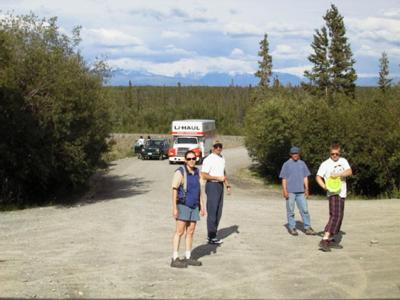
|
|
10 July, 1999
July 10
Today we finally left Anchorage. We were happy to be leaving town, and
itchy to get sight of our field area. We droveŠŠŠ
We picked up Joel Harper on the way out of town. He and his steam drill
are along from the University of Wyoming to place boreholes into the
glacier. From these boreholes a number of measurements will be made. Most
importantly, water level in the borehole will be carefully monitored. In
addition, a borehole camera will be lowered down the hole to look for
"englacial conduits". These conduits are channels of water that melt their
way through the glacier to the bed of the glacier. The drilling work of
Joel Harper is probably the most important to the study.
It took us six hours to travel the first 240 miles from Anchorage to
Chitina, Alaska. It took us an additional six hours to travel the final 60
miles to McCarthy. The going was slow for the truck on the gravel road to
McCarthy. We arrived at 12:30 AM. It was, of course, still light (I'm
slowly getting used to dusk at midnight). The light made pitching tents
easier. We got a brief glimpse of some icefall up the Kennicott Valley.
But for the most part, a thick layer of clouds made visibility of peaks and
glaciers minimal.

The Matanuska glacier, as seen on the way from Anchorage to McCarthy.

The glacier team stopping from a break from a long drive to McCarthy. From left to right: Michelle Cunico, PSU (Portland State University) grad student, Don Lindsay, PSU grad student, Dr. Joel Harper, University of Wyoming glaciologist, Andrew Malm, St. Olaf College undergraduate student. Co-PIs Andrew Fountain and Joe Walder are standing in the background by the SUV (sport utility vehicle). The Wrangell-St.Elias range provides the backdrop.
Contact the TEA in the field at
.
If you cannot connect through your browser, copy the
TEA's e-mail address in the "To:" line of
your favorite e-mail package.
|
